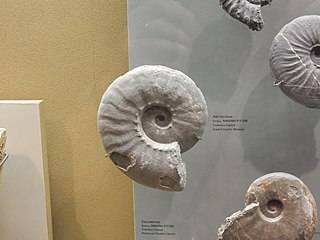Apleuroceras is a genus of ceratitid ammonites with an essentially smooth evolute shell with a subquadrade whorl section and a ceratitic suture with two lateral lobes. Apleuroceras belongs to the Aplococeratidae and has been found in middle Triassic formations of Ladinian age in Hungary and the Alps.
Anasirenites is a genus of extinct ammonoid cephalopods within the family Trachyceratidae which is part of the ceratitid superfamily Clydonitaceae; sometimes considered a subgenus of Sirenites. Anasirenites is characterized by a ventral furrow bordered on either side by a continuous keel. The shell, as for Sirenites, is compressed with whorls flattened-convex on the sides. Sigmoidal ribs on the flanks bifurcate near the ventro-lateral shoulder on tubercles and project sharply adorally. Whorl sides are tuberculate with tubercles arranged in spiral lines. The suture is ammonitic. Anasirenites, first described by Mojsisovics in 1893 is known from the Upper Triassic of the Alps, Sicily, and the Himalaya.
Aplococeras is an evolute discoidal ceratitid ammonite from the Middle Triassic Ladinian stage, found in southern Europe and Nevada. Whorl sides are convex, converging on a rounded venter, and are ornamented with slightly flexuous umbilical ribs that disappear outwardly, towards the venter. The suture has two lateral lobes.

Anolcites is a genus of extinct ammonoid cephalopods from the Middle Triassic belonging to the ceratitid family Trachyceratidae.
Anotoceras is a genus of smooth shelled, discoidal ammonites with a depressed, subtrigonal whorl section and ceratitic sutures included in the ceratitid family Otoceratidae.

Arctoceras is a genus of ceratitid ammonoids from the Lower Triassic with a moderately narrow discoidal shell and ceratitic suture.

Balatonites is a genus of extinct cephalopods belonging to the ceratitid family Balatonitidae. There are at least four known species: B. balatonicus, B. oyama, B. shoshonensis, and B. zitteli.
Glyphidites is a genus of Late Triassic ceratitids included in the family Thisbitidae, characterized by an essentially involute shell with a compressed whorl section, nearly straight sides and arched venter, bearing a serrated keel and granular sinuous ribs.
Ussuria is a genus of Lower Triassic ammonites with a smooth, involute discoidal shell with submonophyllic sutures, belonging to the ceratitid family Ussuriidae.
Homerites is a genus of small, involute, globase fossil ceratitids with an eccentric outer whorl and subammonitic sutures belonging to the family Halortidae The body chamber has a slight central keel and radial dichotomous ribs that commonly terminate at spines on the ventral shoulder. Homerites, described and named by Mojsisovics in 1893 has been found in the Upper Triassic (Carnian) of California and the Alps. The Halortidae in which it is placed is part of the superfamily Tropitaceae.

Ceratitida is an order that contains almost all ammonoid cephalopod genera from the Triassic as well as ancestral forms from the Upper Permian, the exception being the phylloceratids which gave rise to the great diversity of post-Triassic ammonites.

Clionites is a genus of the clydonitoidean family Clionitidae, and its type. The shell is evolute so as to expose all whorls which are covered with generally bifurcating sigmoidal ribs. The suture is ceratitid with two lateral lobes.

Gymnites is a genus of ammonoid cephalopod from the Middle Triassic belonging to the ceratitid family Gymnitidae. These nektonic carnivores lived during the Triassic period, the Anisian age.

The Ptychitidae is a family of ceratitid ammonites. They are combined with the Eosagenitidae and Sturiidae in the superfamily Ptychitoidea.
Sirenites is a genus of ammonoid cephalopods from the Upper Triassic included in the Ceratitida, and type for the trachyceratid subfamily Sirenitinae.
Inyoites is an ammonoid genus from the Lower Triassic, included in the ceratitid family Inyoitidae.
Stenopopanoceras is a genus of involute, discoidal ceratitid ammonites from the Middle Triassic that has been found on Spitsbergen and in arctic Russia and British Columbia.
Parapopanoceras is a ceratitid ammonite with a small, smooth, very involute and moderately globose shell that lived during the middle Triassic.

Ophiceras is an extinct genus of smooth, evolute ceratitid ammonites from the Griesbachian, with a rounded venter. Fossils of the genus have been found in Armenia, Azerbaijan, China, Greenland, and India.
Sturia is a genus of ceratitid ammonoids from the Lower Triassic with an ammonitic suture.







